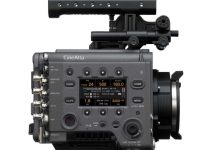Although it may look a bit wimpy, the Crane 2S, Zhiyun’s latest entry into the 3-axis gimbal market, packs one heck of a big punch. It has been fully redesigned and reimagined to support a wider range of cameras that typically don’t fair so well on the a DJI Ronin S (like the Pocket 6K or 1DX III).
But no matter how mighty it may be, how well could this $599 little guy go against something crazy like a MK-V Omega Revolution package which can cost upwards of $200,000? Chris Hau goes for the gold in this David & Goliath match-up hoping that the saying “the bigger they are, the harder they fall” applies to film and video equipment too.
I’m going to break with format and start off with declaring a winner – it was the $200,000 MK-V Omega Revolution Rig, but not by much. In fact, I think it was almost a tie.
Chris was up against a high-end Steadicam team, who specialize in this work every day. They were equipped with a wireless monitoring station, a wireless follow focus, and two decades of experience.
Three people were doing the job of stabilizing and shooting with the Epic-W and Chris was on his own with nothing but a $599 gimbal and an A7r III – relying on algorithms, and autofocusing.
Pitting these two systems against one another is frankly a bit ridiculous, but that is precisely the point.
Let’s break down the parameters of the test.
Tracking Shots
Steadicams were designed for this linear, tracking style of camera movement. Prior to the existence of the steadicam, the only way to film a smooth tracking shot required setting up lots and lots of dolly tracks.
The test here is pretty simple, tracking the subject from behind initially, and arcing around to a profile shot. The biggest challenge isn’t for either of the gimbals but for the autofocus system in the Sony A7rIII.
The Steadicam team is pulling focus for the operator off camera, but Chris is relying on the AF system to keep things crisp. Surprisingly, it stays pretty much on the money even with objects passing in front of the camera. The team, on the other hand, buzzed focus a few times.
I’m calling this a tie.
Obstacles
A bit of a repeat, this test is, again, a tracking shot, but this time there is a twist. The operators will have to step over a lens case to see is the step up is visible in the footage.
Suited-up with a perfectly dynamically-balanced rig and a spring-loaded arm for the 4th axis of stabilization, the pro team nails it. They do this every day and have years of dedicated, specialized experience.
This is less of a test of the system, and more a test of Chris’s arm. He is providing the 4th level of stabilization and although the step is noticeable in his footage because he is counteracting his step-up (or at least trying the best he can), and it really isn’t that bad.
Chris doesn’t have a spring-loaded arm support and if he did, I think he would have tied in this category as well. Steadicam makes a product called the Steadimate S that can be used to attach single-handed gimbals to a support arm.
Orbital Motion
Switching it up to telephoto lenses, they each perform an orbital motion around the subject. This is a decisive victory for the pro team, but it isn’t their gimbal that wins. The motion of the MK-V rig and the Crane 2S are almost indistinguishable.
The Epic-W with Zeiss ultra primes is the winner here. The lenses are cleaner, clearer, and have less distortion. Moreover, since the Epic-W doesn’t have an IBIS situation micro-jitters aren’t present in the footage.
Lens Changes and Setup Tim
The Pro-Team is able to best Chris ONLY by 36 seconds to complete a lens change in 1:44 to Chris’ 2:08. Again, this is something they do every day. They train and practice this repeatedly since this work is crucial to eliminating downtime on a professional set.
Chris is doing this alone with a gimbal that is new to him, and the 200-400mm lens that he is fixing to his camera is a massive weight change for such a small camera. Against those odds, 36 seconds behind an absolute pro should be considered a win.
Vortex Mode
Despite being mounted into a roll cage, this is a massive loss for the Pro-Team’s MK-V system. Their roll axis is off center from their lens and the vortex shot would be virtually unusable in post.
Chris’ shot isn’t 100% perfectly centered either, but it is much closer. Both camera rigs would have to be perfectly rigged and balanced to perform this motion accurately.
Conclusion
The Zhiyun Crane 2S is one heck of a fantastic gimbal. You’re getting a lot of ability for a very low cost with a system like this one.
On a high-end professional film set, the client is paying for professionalism and no mistakes. To meet those demands, you need a system like the MK-V Omega Revolution, and a dedicated team of trained operators.
If I had invested $200K in a system like this, I might start to get a little worried. With cameras like the RED Komodo, which offer a very professional image capture in a small body, a system like the Zhiyun Crane 2S might be finding its way onto a high-end set in the near future.
[source: Chris Hau]
Order Links:
Zhiyun-Tech CRANE 2S (B&H, Amazon)
Disclaimer: As an Amazon Associate partner and participant in B&H and Adorama Affiliate programmes, we earn a small comission from each purchase made through the affiliate links listed above at no additional cost to you.



